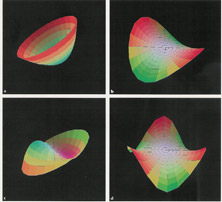Optics aberrations
Until recently, the analysis of vision was expressed in terms of sphere (myopia or hyperopia), and cylinder (astigmatism) characterized by a power and an axis. In most cases the sphere and the cylinder combine to create sphero-cylindrical aberrations.
They are by definition called “LOW-DEGREE ABERRATIONS”.
These refractive errors are the basis of all corrections by corrective lenses which are always expressed (international name) in Sphere (cylinder and axis).
Example: -3.00 (-1.00 at 15°).
In recent years, research in optics and the availability of new devices (aberrometers) have made it possible to understand that vision is not only the association of low-degree errors, but the combination of multiple optical anomalies which integrate high-degree optical aberrations according to mathematical formulas called Zernike polynomials.

The best known are coma, spherical aberration, trefoil etc. these are the “HIGH DEGREE ABERRATIONS ”.
Thus, like a fingerprint, each individual presents a unique vision made up of the combination of multiple aberrations of low and high degrees.
In practice, the rate of high-degree aberrations does not exceed a very small percentage in most individuals, making it negligible to take these elements into account for laser treatment. Conversely, for some, the percentage of high-degree aberrations becomes sufficiently significant for personalized treatment to be necessary.
The Laser Mont-Blanc center is equipped with the entire system allowing personalized aberrometric processing: Analysis of all aberrations by the Wave Analyzer, the Topolyser Vario, the Pentacam and the use of specific processing software by the EX500 Alcon.


